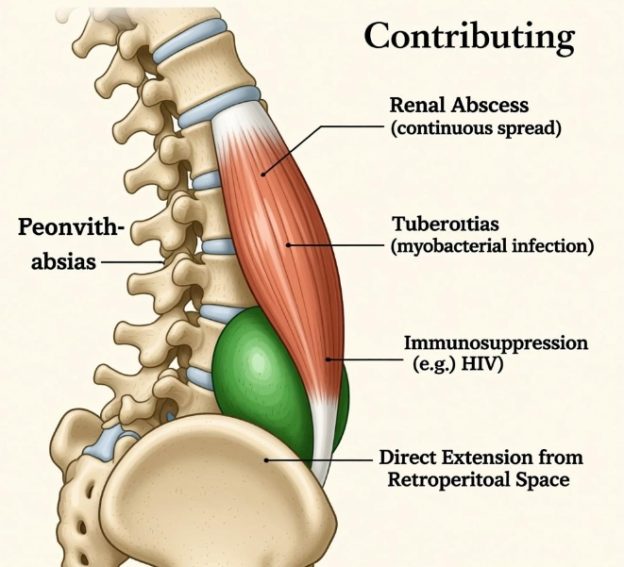Psoas abscess is a purulent collection within the psoas muscle, usually spreading from spinal, urinary, or gastrointestinal infections. Clinical presentation is often insidious and easily missed:
- “Flank” or lower-back pain
Dull, persistent ache that radiates to the anterior hip or groin; movement, walking, or hip extension markedly worsens the pain. - Flexion contracture of the hip
Involuntary flexion and external rotation relieve tension on the psoas sheath, so patients walk with a limp or cannot fully straighten the leg. - Palpable or visible mass
A tender, sausage-shaped swelling may be felt below the inguinal ligament or in the lateral flank, especially if the abscess is large. - Fever and night sweats
Low-grade or spiking pyrexia, chills, and drenching sweats are common; elderly or immunosuppressed patients may be afebrile. - Leukocytosis and raised inflammatory markers
Blood tests usually show neutrophilia, elevated CRP and ESR; these indices help monitor treatment response. - Compressive neuropathy
Extension into the iliac fossa can compress the femoral or obturator nerve, causing thigh numbness, weakness, or referred knee pain. - Systemic toxicity
Persistent bacteraemia may lead to tachycardia, hypotension, and multi-organ dysfunction if drainage is delayed.
Because pain is referred to the hip, the diagnosis is often confused with arthritis, disc herniation, or appendicitis. Any patient with back/hip pain, flexed hip posture, and fever merits urgent spinal/abdomen CT or MRI to confirm the collection and guide percutaneous or surgical drainage.
| Symptom | Typical Pattern | Complication Flags |
|---|---|---|
| Pain | Flank → groin, hip flexion relieves | Severe, bilateral, sciatica |
| Hip | Fixed flexion, limp | Contracture, nerve palsy |
| Mass | Tender “sausage” in groin | Rapid enlargement |
| Fever | Spiking, night sweats | Rigors, hypotension |
| Labs | ↑WCC, ↑CRP, ↑ESR | Rising despite antibiotics |
| Systemic | Malaise, weight loss | Sepsis, multi-organ failure |
